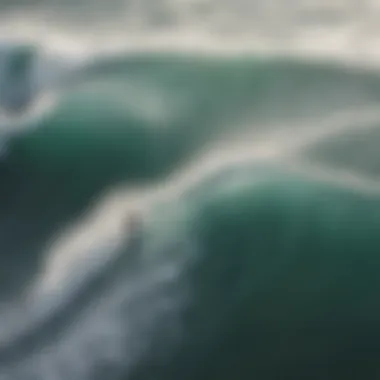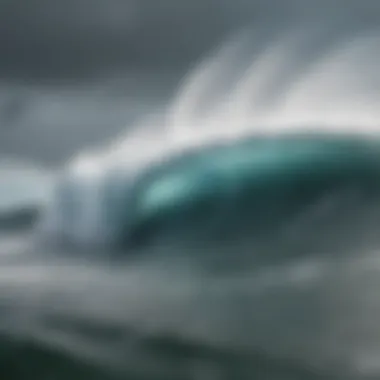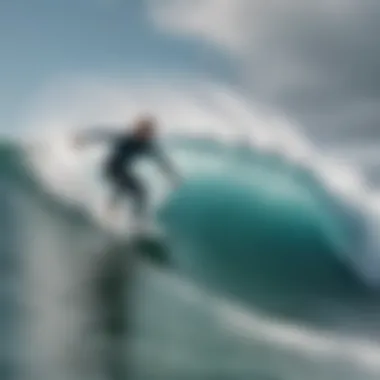Understanding Wind Gust Forecasts and Surfing Impacts


Intro
When it comes to surfing, the ocean doesn't just throw waves your way; the wind plays its own role in shaping the experience. Understanding wind gust forecasting might not be on the minds of every surfer, but it is fundamental for adapting one’s techniques and strategies. A gust here, a breeze there can shift the dynamics of the surf from idyllic to chaotic, leaving one to ponder their next move.
Navigating wind conditions is akin to understanding a musical score; it requires both knowledge and practice to interpret the nuances effectively. This guide aims to shed light on the importance of wind gust forecasts, focusing on the technology behind surfing gear and techniques that depend heavily on wind patterns. Whether you're just starting out or you're a seasoned surfer finding new challenges, knowing how the wind affects your ride is key to enhancing your surf experience.
Let’s peel back the layers on surf gear and equipment, starting from the innovative tech in surfboards through to the essential accessories every surfer should have. This information will serve as a springboard into the more nuanced aspects of surf techniques and skills that rely on wind conditions.
Let's dive deep into these elements to get a clearer picture of what every surfer should consider when tackling the waves.
Prelude to Wind Gusts in Surfing
Wind gusts play a pivotal role in shaping the experience of surfers, and understanding these phenomena can be the make-or-break factor for a successful day out on the waves. A gust isn’t just a brief burst of wind; it can create a ripple effect on wave formation, influence surf conditions, and even affect surfers’ safety. With each gust, the ocean's temperament can shift dramatically, transforming glassy waves into choppy chaos in the blink of an eye.
As surfing enthusiasts dive into this intricate world, it’s crucial to have a grasp on what wind gusts are and why they matter. Knowledge about wind patterns can help surfers make informed decisions, ensuring they hit the surf at the right time, thus allowing for an optimal experience. Understanding wind gusts can not only enhance performance but also bolster safety measures for those riding the swells.
Definition of Wind Gusts
Wind gusts are quick, short-lived bursts of wind that can vary in intensity and duration. They can be caused by several factors, including terrain variations, weather systems, and even the local climate. Typically, a gust is defined as a wind speed that exceeds the average speed at a certain point, often lasting less than 20 seconds.
These fluctuations can occur suddenly, like a surprise twist in a plot, catching surfers off-guard. For instance, when a gust rolls in, it may not just ripple the water's surface; it can shift the direction of waves, creating new surfing dynamics. Therefore, knowing how to respond to these gusts is essential for every surfer.
Significance in the Surfing Context
The significance of wind gusts in surfing cannot be overstated. They are integral in shaping the wave conditions that surfers depend upon for that ideal ride. Here are several points illustrating their importance:
- Wave Shape and Height: Gusts can elevate wave height and modify their shape. A well-timed gust can turn a mediocre wave into a powerful ride.
- Surfboard Handling: Surfers must adjust their techniques according to the wind’s influence on their board, as gusts can affect balance and maneuverability.
- Safety Factors: Strong gusts can create hazardous conditions, leading to unexpected wipeouts or difficult paddling situations. Awareness of wind gust forecasts allows surfers to choose safer times to surf.
- Local Surf Culture: Many surfing communities rely on local knowledge regarding wind patterns to forecast the best times for surfing. Understanding such gusts is part of this culture.
Wind gusts are like the wild card in a game; knowing how to read them makes all the difference.
Ultimately, grasping the definition and significance of wind gusts equips surfers with the knowledge needed to navigate their conditions more proficiently. With the right information, surfers can not only enhance their skills but also deepen their appreciation for the intricate relationship between wind and water.
Factors Influencing Wind Gusts
Wind gusts can drastically alter surfing conditions, making an understanding of their underlying factors crucial for any surfer aiming to ride the best waves. While you may feel the wind on your face while waiting for the next set to roll in, several factors affect those gusts, leading to changes in wave quality, consistency, and safety.
Geographical Influences
The shape and layout of the coastline play pivotal roles in how wind gusts behave. From towering cliffs to gently sloping shores, wind can vary immensely based on geography. For instance, surf spots near cliffs experience unique wind patterns, where gusts may funnel through narrow openings, intensifying their strength unexpectedly. Recognizing these geographical peculiarities is essential for surfers who wish to predict wind behavior and its effects on wave quality.
Additionally, the presence of natural features like islands and sandbars further influences wind flow. Waves breaking on a sandbar might differ from those crashing against a rocky shore, and knowing this could help surfers determine which locations are more favorable on a given wind day.
Meteorological Patterns
Weather systems are another crucial element when considering wind gusts. High and low-pressure areas can create radically different wind conditions that surfers must account for. A low-pressure system often leads to strong, turbulent winds, while high pressure tends to bring calmer breezes. By keeping an eye on local meteorological conditions, surfers can glean insights into how wind gusts might vary throughout the day.
During storms, gusty winds can create choppy waters, transforming otherwise manageable surfing conditions into a chaotic experience. Conversely, post-storm periods might lead to cleaner swells as winds settle down, creating ideal conditions for catching waves. Understanding these patterns allows surfers not just to survive the ocean’s whims but to thrive within them.
Seasonal Variations
The seasons can fundamentally change wind behavior, creating distinct surfing experiences. In summer months, coastal areas often enjoy lighter winds and more stable weather conditions, which makes for smoother waves ideal for novices or those who favor gentler rides. Winter, on the other hand, can introduce intense wind patterns, often leading to larger and more powerful waves, perfect for seasoned surfers seeking thrills.
Additionally, certain seasons might bring regional phenomena, like monsoons or trade winds, which can either boost or diminish wind strength and consistency. Monitoring seasonal changes can be beneficial for surf enthusiasts planning trips or looking to hone their skills in dynamic environments.
"Understanding the factors that influence wind gusts is like holding the key to the ocean’s moods; it sets you on the right path to choosing your battles wisely."
Ultimately, being aware of how geographical features, meteorological influences, and seasonal shifts interact provides surfers with the knowledge to make informed decisions. Whether it's choosing the right surfboard or picking the perfect spot, understanding these factors lays the groundwork for safer and more exhilarating surfing experiences.
Technological Approaches to Forecasting Wind Gusts
Forecasting wind gusts has come a long way from the basic observations of the past. Today, technology plays a crucial role in how surfers and meteorologists gauge wind conditions, impacting surfing experiences everywhere. Being able to predict gusts not only helps surfers know when to hit the waves but also improves safety and ensures preparedness for changing conditions. In this section, we'll explore the key technological methods that aid in forecasting wind gusts and their relevance to surfing.


Weather Satellites and Remote Sensing
Weather satellites are a game changer in the field of meteorology. They provide a bird's-eye view of atmospheric conditions, using advanced sensors to gather data on wind patterns, humidity, and temperature from high above. Remote sensing technology allows for measurement of various atmospheric components, including the wind’s speed and direction.
- Satellite imagery can show cloud movements that indicate shifting winds, helping surfers plan their surf trips more wisely.
- Real-time data from these satellites can often predict severe wind gusts that might make or break a surfing day.
Notably, systems like the Geostationary Operational Environmental Satellites (GOES) have revolutionized how weather updates are broadcasted. This information is crucial because it helps surfers spot potential surfable swells while avoiding unpleasant surprises.
Numerical Weather Prediction Models
Numerical Weather Prediction (NWP) models utilize complex mathematical equations to simulate the atmosphere. These models run on supercomputers, interpreting vast amounts of data gathered from weather stations, buoys, and satellite observations. This technology allows for nearly accurate forecasts regarding wind speeds and gust conditions days or even weeks ahead. Some key points about NWP models include:
- Precision in Forecasts: Surfers rely on NWP models because they provide detailed predictions tailored to specific locations. This accuracy minimizes uncertainty when making plans to surf.
- Guidance on Wind Patterns: These models help in understanding prevailing winds, crucial for deciding whether a surfer should paddle out that day or wait for calmer conditions.
By continuously refining these models, meteorologists can produce forecasts that adjust with real-time data, allowing for updates that reflect changing conditions as they unfold.
Local Observational Techniques
While satellite data and numerical models are invaluable, local observational techniques cannot be overlooked. Experienced local surfers often possess a wealth of knowledge regarding how the wind typically interacts with local geography, impacting the surf conditions significantly.
- Community Reports: Gathering information from local surfers about their daily experiences can provide insights that models might miss. When surfers share their observations, it creates a rich tapestry of data that enhances its overall accuracy.
- Wind Measurement Stations: Installing anemometers at popular surf spots can give real-time data on wind speed and direction directly from the surf zone.
Local observational techniques serve as a bridge, connecting formal data collection with experiential knowledge. This blend creates a powerful forecasting tool that can dramatically enhance surfers' abilities to read wind gust conditions effectively.
"The sea's fury is sometimes calmed by friendly winds, so knowing when to surf can mean the difference between an exhilarating ride and a challenging struggle."
Through combining these various methods—satellite data, NWP models, and localized observations—surfers can craft a more comprehensive understanding of wind gust forecasts. This integration not only boosts their surfing skills but also contributes to safer and more enjoyable experiences on the water.
Reading and Interpreting Wind Gust Forecasts
Wind gust forecasts are more than just numbers on a screen; they are vital indicators that can shape the experience of a surfer on the water. Understanding these forecasts means you can ride the waves with confidence, ensuring a safer and more enjoyable outing. Knowing how to read and interpret these forecasts can help surfers make informed decisions and tailor their approach according to the conditions presented.
Understanding Forecast Metrics
When it comes to wind gusts, there are a few key metrics that every surfer should be familiar with. These figures often come with a myriad of terms that can be tricky to decipher. Here’s a quick rundown:
- Maximum Wind Gust: This represents the highest speed of wind gusts over a specific period. It's essential to be aware of this to anticipate potential turbulence on the water.
- Sustained Wind Speed: This is the average wind speed over a duration, usually measured in miles per hour or knots. Understand this figure to gauge the overall wind strength.
- Wind Direction: Knowing from which direction the wind is blowing helps surfers understand wave conditions and which beaches might be suitable for catching a ride.
Interpreting these metrics correctly allows surfers to align their skills and equipment. For example, a high maximum wind gust paired with a strong direction can create challenging wave conditions, pushing even seasoned surfers to consider different techniques or perhaps change their surf location.
Identifying Reliable Sources
In an age where information is abundant but accuracy can waver, identifying trustworthy sources for wind gust forecasts is crucial. Here are some pointers for finding reliable insights:
- National Weather Service: This governmental authority provides up-to-date and scientifically researched forecasts. Utilizing their resources can offer peace of mind.
- Specialized Surf Forecasting Websites: Platforms like Surfline or Magicseaweed often provide localized forecasts and user-generated reports that can be invaluable. Surfers can get an inside scoop about the wind conditions expected at their favorite spots.
- Mobile Apps: There are numerous applications that offer real-time updates and push notifications on weather conditions. Look for apps that are rated highly and have solid user reviews.
- Local Surf Shops or Schools: Engaging with the community can provide firsthand knowledge. The locals often have a pulse on the wind conditions and what to expect during a session.
"It's not just about checking the forecast; it's about tuning into the environment and what it has to offer."
Mastering how to read and glean insights from wind gust forecasts can significantly enhance a surfer’s ability to navigate the waves. By understanding the vital metrics and tapping into dependable sources, surfers can take their sessions from merely mediocre to extraordinarily exhilarating.
Impact of Wind Gusts on Surfing Conditions
Understanding the impact of wind gusts on surfing conditions is essential for surfers who want to enhance their performance and safety. Wind gusts can dramatically influence wave behavior, surfboard control, and overall safety in the surf. Grasping these dynamics can help surfers make informed decisions before hitting the waves, ultimately leading to a more enjoyable and productive experience.
Wave Formation and Direction
Wind movements create and shape waves, playing a significant role in their formation. The interaction between wind gusts and ocean conditions can lead to different types of waves. For instance, strong gusts can cause abrupt fetch, the distance over which the wind blows over the water, resulting in steep, choppy waves. This can affect the ride considerably. Additionally, wind direction relative to the waves can alter their shape as well.
- Onshore Winds: These winds blow from the sea towards the land, creating waves that tend to break faster and can lead to a more turbulent surf experience. They can churn up the water, allowing for short, steep waves that often become unruly.
- Offshore Winds: Conversely, offshore winds, which flow from the land to the sea, can smooth out the surface, allowing for longer rides and allowing waves to form a cleaner face. These conditions are generally preferred by surfers as they create more predictable wave patterns.
By understanding these wind patterns, surfers can better predict which conditions will provide the best experience for their skills and preferences.


Surfboard Handling and Management
The unpredictable nature of wind gusts requires surfers to adjust their handling techniques. When surfboards are subjected to gusty winds, they become more challenging to control. Surfers may find they need to adopt different techniques or manage their boards more carefully.
- Foot Placement: It's crucial to adjust foot positioning to maintain balance and control. Shifting the back foot slightly can help the surfer respond quicker to changing conditions.
- Body Positioning: Leaning lower to the board can help lower the center of gravity, proving advantageous when catching waves in windy conditions.
Surfers must also be aware of their equipment. A board suited for calmer conditions may not perform well amid gusts. Opting for a shorter board or one designed for high performance can make a marked difference in handling.
Safety Considerations for Surfers
When wind gusts pick up, safety becomes a primary concern for surfers. The unpredictable nature of gusty conditions can lead to an increased risk of accidents and injury. Surfers need to be vigilant and prepared for sudden changes.
- Checking Weather Reports: Regularly consulting wind forecasts as well as local conditions can help in planning sessions. It's key to keep an eye on gust predictions.
- Awareness of Surroundings: Being mindful of the surf spot is vital. Familiarizing oneself with the local geology is necessary. Strong gusts can shift quickly and change currents, leading to dangerous riptides or hazards lurking below the surface.
- Buddy System: Surfing with a partner means you always have someone to help or communicate with if conditions worsen unexpectedly.
"Safety is not just about avoiding danger; it's about knowing when to paddle out and when to stay on the beach."
Strategies for Surfers Based on Wind Gust Framing
The connection between wind gusts and surfing conditions can’t be overstated. Understanding how to navigate these gusts isn’t just about catching waves; it directly enhances a surfer's performance and safety. With the unpredictable nature of wind, having solid strategies based on wind gust forecasts becomes essential. This section dives into adaptive techniques and spot selection, emphasizing how these approaches can elevate surfing experiences.
Adapting Surfing Techniques
When wind gusts come into play, surfers must fine-tune their techniques. This adjustment can be crucial, not only for improving ride quality but also for ensuring safety amidst changing conditions.
- Balance and Stance: Wind can affect balance significantly. Surfers should adopt a low center of gravity stance, crouching down slightly to maintain stability as gusts pick up.
- Paddle Power: Utilizing stronger paddling techniques when facing headwinds is vital to making headway. Energetic strokes can help counteract the gusts that may be trying to push you off course.
- Wave Selection: Not every wave behaves the same under windy conditions; some might become choppy while others maintain form. Surfers should observe and choose waves that remain aerodynamic.
- Timing Is Key: Understanding the window of calmer periods can be invaluable. If surfers can wait out the worst gusts, they can ride more predictable swells.
Implementing these techniques allows surfers to adapt to conditions dynamically and maximizes the enjoyment of their time on the water.
Choosing Suitable Surf Spots
Not all beaches are created equal when it comes to wind effects. Some spots benefit from wind and can provide ideal surfing conditions while others can become quite hazardous. When framing strategies around wind gust forecasting, selecting the right surf location is paramount.
- Protection from Wind: Areas like coves or beaches with natural formations can significantly shield surfers from harsh gusts. Picking spots that offer geographical barriers can provide a more stable surfing experience.
- Check the Orientation: The beach orientation relative to the wind direction plays a huge role. East-facing beaches may receive direct winds, while south-facing spots might provide more favorable conditions.
- Consult Local Knowledge: Tapping into the wisdom of local surfers who’ve spent years studying the winds can offer insights that forecasts simply miss. These individuals can pinpoint the best spots based on wind history.
It’s wise for surfers to keep an eye on the local wind currents and patterns in addition to using technological tools. This dual approach can drastically improve outcomes on the water.
The Role of Local Knowledge in Wind Forecasting
Local knowledge is often a gold mine of information that waiting to be tapped when it comes to predicting wind gusts and their effects on surfing conditions. While high-tech tools and advanced models give a lot of data, they may miss that peculiar flair local conditions bring. Understanding subtle local patterns can put a surfer ahead of the game, risking not just catching waves, but also doing so safely and effectively.
A strong grasp of local conditions can fill in the gaps that broad meteorological forecasts often overlook. For surfers, this means recognizing how certain regions might react uniquely to wind patterns. For instance, the way the dunes at Malibu interact with the breeze can skyrocket wave quality, while the swells at Waimea might behave differently under seemingly identical conditions.
Moreover, local knowledge can help in better tailoring surfing strategies. Knowing when the local break works best under varying wind conditions, such as northeast winds being more favorable for certain spots like La Jolla, can frame whether it's worth heading out or enjoying a lazy day at the shore.
Community Insights and Historical Data
Communities that have been surfing in the same areas for generations possess a treasure trove of insights. Their anecdotes can provide valuable historical data about surfing conditions through the seasons. For instance, surfers might share stories about a particular swell and how wind gusts transformed the break, which can aid in forecasting future swells simply based on historical recurrences.
Gathering this kind of information doesn’t always require formal studies but can be as simple as starting a conversation at the local surf meet-up. Here’s how community insights can be invaluable:
- Experience-Based Knowledge: Older surfers can offer opinions on how the waves generally behave in specific wind conditions.
- Spot Knowledge: Local surfers often know the best spots that might not be on the radar of new surfers, or even forecast services.
- Patterns Over Time: Understanding how certain wind patterns behave during different seasons, based on prior experiences, helps to predict upcoming conditions better.
Networking with Local Surfers
Building connections with local surfers is key for anyone keen on mastering the local waves. Networking provides real-time insights that weather apps and forecasts can not match.
- Join Local Forums: Engaging in local forums or social media groups like those on Reddit can help you connect with experienced surfers.
- Attend Surf Events: Participating in local competitions or even just watchin' can lead to chats that unveil hidden insights about local wind patterns.
- Surf Together: Sometimes being out in the water with the locals is the best way to feel the rhythm of the waves and wind.
This kind of interaction not only broadens your network but also enriches your understanding of local conditions. Attack the ocean with the wisdom passed down through generations, and you may just find that edge you're looking for when catching that perfect wave.
Understanding the nuances of local conditions can mean the difference between a good surf and a potentially hazardous experience.


Environmental Considerations
Understanding how environmental elements play a role in wind gust forecasting is vital for surfers and those who enjoy coastal activities. The interaction between the atmosphere and ocean conditions is complex and continually changing, yet it holds significant implications for surfing. It’s more than just a matter of catching waves; it’s about recognizing how these nuances affect wave quality, safety, and overall enjoyment.
Effects of Climate Change on Wind Patterns
The influence of climate change on wind patterns cannot be overstated. Research shows that as global temperatures rise, wind systems across the globe are also undergoing shifts. These changes can lead to alterations in the frequency and intensity of wind gusts, making prediction harder and more variable. While surfers often rely on weather forecasts, an erratic climate can render traditional predictive models less reliable.
- With altered wind patterns, surfers may face:
- More unpredictable wave conditions: Variability can lead to unexpected dangers or prime conditions.
- Changes in local microclimates: This can affect local surf spots that depend on specific weather conditions.
Communities that surf regularly need to heed these changes. By aligning with local meteorologists and obtaining real-time data, surfers can learn about approaching conditions. Emphasizing sustainable practices and environmental stewardship, surfers can contribute to the health of their coastal regions, which is essential in the fight against the adverse effects of climate change.
"As the environment changes, we must adapt not only our techniques but our understanding of the wind's effects on surfing. We surfers are the stewards of the waves we ride."
Ocean Conditions Affected by Wind
The interplay between wind and ocean conditions is foundational to surfing. Wind plays a pivotal role not just in generating waves but in how these waves behave once they hit the shore. Stronger winds can generate larger swells, but their direction and consistency also play critical roles in shaping surf conditions.
When examining this relationship, a few factors come into play:
- Wind Direction: The angle at which wind blows over the water can create or diminish wave power. For instance, offshore winds are often favorable as they groom the waves, while onshore winds might chop them up, resulting in less desirable surf conditions.
- Fetch: The distance over which wind travels can impact wave height and power. Longer fetches typically mean more substantial and well-formed waves, while short fetches can lead to choppy conditions.
- Temperature Disparities: Cold water pushed by winds can affect wave dynamics. Warmer waters generally yield more active surf spots.
Ultimately, surfers should meticulously observe their surrounding ocean conditions and anticipate how changing winds might influence their upcoming sessions. With the knowledge of both wind and environmental impacts, surf enthusiasts can make educated decisions on when and where to paddle out, maximizing their experience while staying safe.
Ending
Understanding wind gust forecasts is crucial for surfers as it encapsulates a myriad of factors that influence surfing conditions directly. Accurate weather insights empower surfers to select the best times and locations for their adventures. Not only do surfers enhance their experience in the water, but they also ensure their safety by understanding the unpredictability that wind gusts can impose on ocean waves.
Recap of Key Insights
Throughout this article, we've unpacked various domains relating to wind gusts and their impacts on surfing. Key insights include:
- Definition of Wind Gusts: Recognizing what wind gusts are and how they vary from steady winds is central for any surf enthusiast.
- Factors Influencing Gusts: We discussed how geographical layouts, meteorological conditions, and seasonal shifts contribute to gust patterns.
- Technological Tools: From satellites to local observations, there are various tools available that help surfers stay informed.
- Safety Measures: We highlighted how understanding wind gust reports can significantly enhance safety, providing a buffer against hazardous conditions.
- Local Knowledge: Engaging with community insights enriches one’s understanding of ever-changing local conditions.
This collection of knowledge arms surfers with the capability to make informed decisions, ensuring they ride the waves instead of battling them.
Encouragement to Engage with Regional Forecasts
Evaluating regional forecasts does not merely enhance the surfing experience; it fosters a deeper commitment to informed outdoor activities. Surfers should regularly tap into both regional weather sites and community forums. Websites, like Reddit, often house discussions from seasoned surfers who share real-time insights about local conditions, helping one to stay one step ahead of the game.
Additionally, apps that focus on surfing conditions often provide localized forecasts which can be beneficial. The beauty lies in the fact that wind conditions can differ greatly even within short distances along a coastline. Engaging with these resources doesn’t just serve the purpose of checking for gusty conditions; it nurtures a deeper connection to the environment and fellow surfers.
By aligning with these insights, surfers not only adapt better to atmospheric shifts but also bolster their appreciation for the nuances of nature. Masters of the waves are not just those who ride; it's about understanding the play of nature that enables that experience.
Further Reading and Resources
In any field, especially one as dynamic as surfing, staying updated through further reading and reliable resources is crucial for improving both skills and knowledge. When it comes to wind gust forecasting, gaining deeper insights allows surfers to refine their understanding of how varying wind pressures affect wave behavior. Engaging with supplementary content not only enhances practical knowledge but fosters a culture of learning and adaptation among surf enthusiasts.
Recommended Literature on Wind Patterns
Reading through specialized literature offers a profound perspective on wind dynamics and patterns that can significantly influence ocean conditions. Some key texts include:
- "The Wind and the Sea: Understanding Oceanic Patterns" by Anna D. Fisher—This book examines not just wind patterns, but their direct effect on ocean currents and wave behavior, making it an essential read for practicing surfers.
- "Surf Science: An Introduction to Waves for Surfing" by Tony T. B. Kiter—Kiter’s work breaks down the science behind waves, including how wind interacts with ocean conditions, providing valuable data and theories applicable to modern surfing strategies.
- Scientific Journals and Articles: Websites like Britannica often publish studies examining the correlation between wind patterns and environmental changes. Peer-reviewed articles can also provide recent findings and advancements in wind forecasting technology.
Reading these resources deepens the understanding of, not only how wind affects surfing but also the broader climatic changes that impact our oceans.
Useful Websites and Apps for Forecasting
For modern surf enthusiasts, having real-time data is essential. Several websites and mobile applications provide forecasts specific to wind gusts and how these forecasts can influence surf conditions.
- Magicseaweed: A must-have for surfers looking for comprehensive swell and wind forecasts. This platform provides both long-term and short-term predictions and allows surfers to customize their search based on specific locations.
- Surfline: This site offers highly detailed forecasts including wind conditions, tide schedules, and more. There are also live video feeds from popular surf spots, helping surfers gauge conditions in real time.
- Windy: Excellent for visualizing wind patterns, Windy allows users to see data from around the globe, perfect for planning surf trips or simply checking local conditions before heading out.
- NOAA’s National Weather Service: An official source for comprehensive weather data. NOAA provides alerts regarding wind gusts and other meteorological reports that can help surfers stay informed during unpredictable weather.
Accessing trusted resources and using reliable tools makes a significant difference in a surfer's ability to adapt to changing conditions. Thus, staying informed enhances safety and efficiency in the water.
Exploring these materials and resources can provide surfers with an edge, not only improving their techniques but also ensuring they are tuned in to the ever-shifting nature of their environment.















